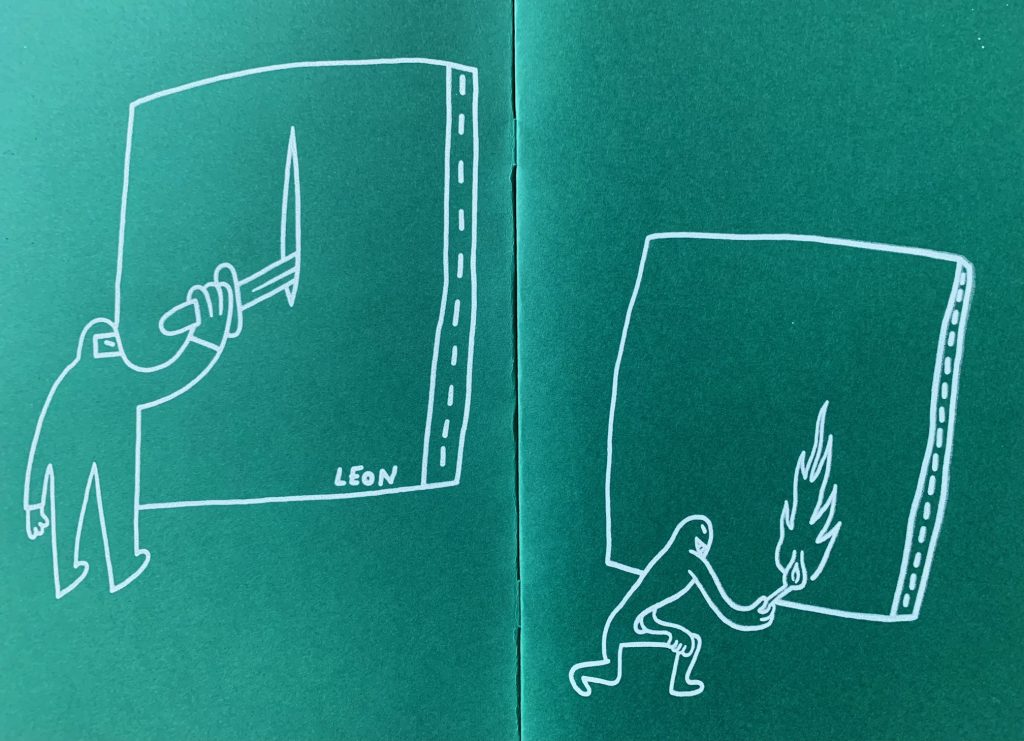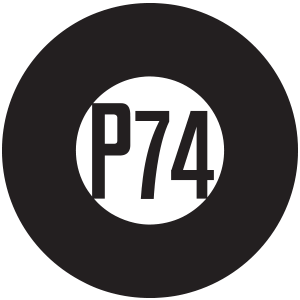
Joachim Schmidt, Art Addicts Anonymous (1993)

Leon Zuodar, I H8 BIG FORMATS (2013)
31 August – 19 September 2023
P74 Gallery
A Kassen, Robert Barry, Eva Hesse, Catherine Griffiths in Dan Rees, Emma Kay, Richard Kostelanetz in David Cole, Jonathan Monk, Paper Monument, Lia Perjovschi, Joachim Schmidt, Tina Smrekar, Mladen Stilinović, Goran Trbuljak, Leon Zuodar
Curator: Nina Skumavc
_____
You are cordially invited to attend the opening of the exhibition Art Addicts on Thursday, 31 August 2023, between 7pm and 9pm at the P74 Gallery in Ljubljana.
The international exhibition, entitled Art Addicts, presents a selection of artworks by authors of different generations and from different environments and contexts. This is the third exhibition to present the works included in the P.A.R.A.S.I.T.E. Artist Book Collection, which features more than 700 works. What the selected publications have in common is that they can be more or less directly understood as a commentary on art, the art system and history, and the artist’s work. Regardless of their publication date, the topics and issues discussed in these publications remain relevant. The exhibition’s title takes from one of the exhibited publications – Art Addicts Anonymous (1993) by Joachim Schmid. Behind the cover, we find a booklet and 12 cards with stereotyped advertisements to help in one’s rehab from their addiction to art. It suggests how a change of profession/work in art brings positive changes in someone’s life.
Lia Perjovschi‘s publication Subjective Art History (-) is designed as an illustrated encyclopedia of art history from modernism to the present. It contains captioned entries and reproductions of selected artworks with subtitles, but this is a subjective selection, and the simple, black-and-white aesthetic and notebook-style binding are in stark contrast to the usually rich editions that introduce the reader to art history in a formal sense and terms of content. Similarly, Emma Kay‘s tiny booklet The Story of Art (2003) talks about art history, where the names of artists, movements and concepts from the art world are listed alphabetically. Still, they are written based on the author’s memory. The record shows the instability of both personal and collective knowledge. The art world today is both socially professional and professionally social. Social rules determine relations between actors. Paper Monument‘s publication I Like Your Work: Art and Etiquette (2009), in which several people from the art world participated, exhibits questions and answers about behaviour in the art world.
Jonathan Monk‘s book Studio Visit (2009) focuses more on the visual than the text, opening a view into the artist’s »hidden« studio through photographs. The publication highlights details from the studio as a space of reflection and freedom. Barely visible portraits in a very light print, accompanied in places by a word or only a cut-off part of it, make up Robert Barry‘s book Autobiography (2006). These are portraits of family, friends, artists, gallerists, curators, collectors and acquaintances, which the artist collected for over 30 years, and it is significant that in terms of the author’s autobiography, they are all treated equally. The publication Datebooks 1964/65 (2006) by Eva Hesse provides an insight into the artist’s life. It is a facsimile of two pocket calendars and a book in which the content of both is reproduced in an edited form. The practical notes of meetings and errands are intertwined with short, diary-like personal notes.
Mladen Stilinović‘s unique book Artist at Work (1978) consists of black-and-white photographs showing the artist at work – while lying in bed. Work. A Manual (2005) by Tina Smrekar shows photographic scenes of the artist at work, at the table, where her positions and gestures change, just like the subtitles and phrases below them. These always include the word »work« and vary the context depending on which word is next to them. Leon Zuodar‘s fanzine I H8 BIG FORMATS (2013) consists of drawings that show various humorous problems and battles of an artist in front of the canvas. They can be understood simply as depictions of artistic blockage, but more broadly also as other obstacles brought by big formats: the required space and financial investment to create and, ultimately, a suitable exhibition space. The reality of creation is also shown in the publication of the art collective A Kassen, Damaged by Water, financed by Insurance (2008), where the title tellingly implies the financing solution for producing the work mentioned. The position of the artist and a commentary on the functioning of the art system is expressed in the book Slogan, Motto, Statements & Posters (2014) by Goran Trbuljak; it contains statements, mottos, slogans, and posters created by the author over several decades of artistic creation.
The medium of the book often serves as a platform for recording unrealised ideas: Catherine Griffiths and Dan Rees recorded them in the publication Home for Lost Ideas (2009), and they invited many artists and curators to contribute. Similarly, a collection of responses comprises the Eleventh Assembling: Pilot Proposals publication (1981), edited by Richard Kostelanetz and David Cole. In their case, it is not about unrealised, but rather utopian projects, as the selected artists were asked to answer the question, in any medium, of what kind of project they would prepare if they could apply for a scholarship of 500,000 US dollars.
_____
A Kassen is an art collective (Ch. Bretton–Meyer, M.S. Hebsgaard, S. Petersen, T. Petersen) working in Copenhagen and Berlin since 2004. They deal with traditional understandings of authorship, appropriation, and evaluation. Their work, which they describe as »performative installation and sculpture«, deconstructs and reconstitutes everyday objects, artworks by other artists and historical exhibitions to question canonised styles and modes of representation of art history and institutional culture.
Robert Barry (1936) is an American artist best known for his conceptual works. He focuses on the transitional and impermanent aspects of space in art, along with the people surrounding, reacting to, and artists rather than the objects themselves. He often includes text in his works to evoke narrative. Since 1967, his artistic practice has been dedicated to immaterial artworks, installations and performative works using many otherwise invisible media.
Eva Hesse (1936–1970) was a German-born American painter and sculptor who is considered one of the pioneers of using unusual materials such as latex, rubber tubes, glass wool, synthetic resins, rope, rags and wire. Despite her short career, which was extremely fruitful, she was placed in the post-minimalism movement of the 1960s. Her work contains a tension between deliberation and spontaneity, structure and disorder, a kind of search for a balance between discipline and freedom within the whole.
Catherine Griffiths (1966) and Dan Rees (1982): Griffiths is a designer, artist, writer and activist from New Zealand; Rees is a multidisciplinary artist working in Berlin. Together, they edited the book Home for Lost Ideas, a collection of contributions from 80 artists and curators of projects that were unrealised, unfinished, or abandoned. The book represents an insight into an unseen part of artistic practice.
Emma Kay (1961) is an artist who lives and works in London (Great Britain). She is interested in individual memory and how it processes maps, literature, religion and history. What fascinates her are distorted facts and massive omissions. In her work, she deals with contemporary topics but simultaneously investigates some obscure phenomena, questioning the self-evidentness of collective understanding based on the abilities and shortcomings of individual memory.
Richard Kostelanetz (1940) and David Cole (1968): Kostelanetz is an American artist, author and critic; Cole (also known as David Stein) is an American film director. In 1970, Kostelanetz began publishing the Assemblings series of publications, where he published contributions from various contemporary manuscripts by other authors – artists, poets, and writers. Selected authors are invited to send works on paper in a specific format and in 1000 copies, from which they make 1000 copies of a single issue of the publication. A total of 12 issues were released; Cole participated in the last ones but was not present from the beginning.
Jonathan Monk (1969) is a British artist who, through various means, repeats, renews and re-explores the critical works of conceptual art and the art of minimalism. Appropriation has been present in his work since the beginning. Through murals, monochromes, ephemeral sculptures and photography, he reflects the tendencies of contemporary art while at the same time creating homage to authors such as Sol LeWitt, Ed Ruscha, Bruce Nauman, and Lawrence Weiner and demystifying the creative process.
Paper Monument is a Brooklyn / New York-based non-profit art press dedicated to presenting smart, serious writing accessible to a broad audience. Their books and journals on contemporary art explore topics often overlooked by mainstream journalism. Paper Monument is published by the n+1 Foundation and designed by Project Projects.
Lia Perjovschi (1961) is an artist from Romania who creates in various media, from performance to assemblage, from drawing and text to site-specific installations of objects, facts, diagrams, mind maps and timelines. She is concerned with creating opportunities for intellectual exchange, focusing on collecting, archiving, structuring, distributing and mediating a wide range of knowledge about society, politics and art.
Joachim Schmidt (1955) is a Berlin-based conceptual artist and critic who collects and reuses photographs that others throw away. He has been focusing on recycling existing photographs since the early 1980s. With the development of the digital age, he directed his practice to the Internet, where he continued to reflect on the development of photography in a globalised culture.
Tina Smrekar (1978) is a visual artist based in Ljubljana who creates in various media like photography, video, installation, research projects, and performances. Her latest series of works deals, from different perspectives, with artists’ working and living conditions in various environments. She is the founder and producer of Studio Finta, through which she realised several short animated films. She is also active in the Slovenian Animated Film Association, which connects Central and Eastern European experts.
Mladen Stilinović (1947–2016) is considered one of the most influential and important neo-avant-garde artists from the former Yugoslavia. After initially writing poetry and making experimental films, he devoted himself to visual art from the 1970s onwards. He created collages, photographs, artist books, paintings, installations, actions, movies and videos. He focused on the power relations that pervaded society at the deepest level and presented them ironically and humorously. He appropriated slogans, phrases and metaphors from everyday political speech for his artistic statements, deconstructing their original meaning.
Goran Trbuljak (1948) is a Croatian visual artist, one of the pioneers of conceptual art, director and creator of animated films. He has been active since the late 1960s and is placed in the context of new artistic practices. In his playful and ironic work, he examines the mechanisms that make something accepted as art. This approach implies a particular moral stance, the desire to remain independent of the art system by distancing oneself from it and exposing its principles and mechanisms.
Leon Zuodar (1977) works with drawings, graphics, paintings, zines, animations, and comics. Specific to his approach are simple delivery of content, instant effect and humour. His animations and graphics feature a recognisable visual language derived from a simply designed drawing. Based on a compelling narrative, Zuodar’s drawings consciously challenge the norms of high art with its »trashy« design, supported by the aesthetics offered by worn-out technology and broken photocopiers. Zuodar is part of the White Ice Cream Group, which received the OHO Group Award 2011.
